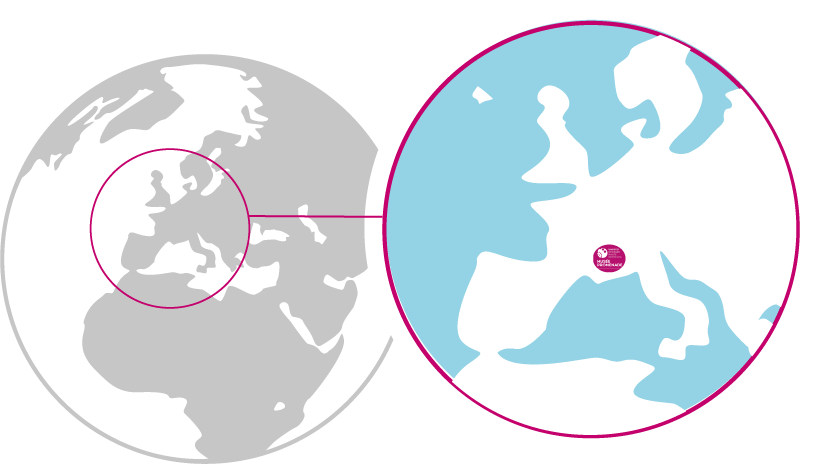UNESCO Global Geoparks
What is a Geopark?
The notion of a UNESCO Global Geopark emerged in the 1990s. With its roots in the current #1Haute-Provence UNESCO Global Geopark, it is the result of a long development process and the unfailing commitment of #2passionate geologists.
A Definition
The aim is to put geological heritage at the core of sustainable development in an identified area by closely associating it with the other natural, cultural, tangible or intangible components that form the identity of the area.
A Quality Label
The #3UNESCO Global Geopark label is awarded to a rural area for the diverse richness of its geological, natural and cultural heritage. These prerequisites are the basis of this Quality Label, which is granted for #44 years and renewable by UNESCO (United Nations Educational, Scientific and Cultural Organisation).
Specific Missions
Geoparks start with #6geological sites. As witnesses of our planet's history, their study allows us to understand the Earth's long evolution and also to better understand the balance of our current ecosystem. As such, they constitute a precious and unique heritage.
A Geopark's mission is therefore to enhance the intrinsic value of all of these heritages by developing reasoned and rational actions. In particular, it aims to :
- Preserve #7geosites which, by their very nature, are as vulnerable as living organisms: due to erosion, earthquakes, alteration; all processes that damage them.
- Develop and maintain geological awareness among the general public through educational initiatives.
- Encourage a strategy of #9sustainable economic and tourist development.
- Involve local inhabitants in this approach, as #10partners, stakeholders and essential representatives of the development and promotion of the region concerned.
- Promote an overall inclusive-approach in which all #11local heritage is highlighted.
However, a Geopark is not an additional regulatory tool. Geoparks generally use existing laws and regulations to preserve their heritage.
Territorial Development for International Influence
Through the various actions described above, a UNESCO Global Geopark is therefore a special kind of territorial development agent, but a development agent in its own right! Moreover, thanks to its Label and its participation in the UNESCO global network, it brings a strong international influence to this territory.
Today, #12147 UNESCO Global Geoparks are spread across all continents.
A Full UNESCO Programme
On November 17th 2015, at the 38th General Conference of UNESCO, the 195 member states of the United Nations adopted a new programme: the International Geosciences and Geoparks Programme (IGBP). Geoparks become a full UNESCO programme.
For more information: #14The statutes of the International Geosciences and Geoparks Programme.
Legal Status / Juridical Entity
Each Geopark has a specific juridical entity. The specific juridical entity of Geoparks takes into account the local context and conforms to the legislation of the country where it is established. For example, #15the Haute-Provence UNESCO Global Geopark spans two Inter-Municipal authorities : #16the Inter-Municipal Council of the Provence-Alps Metropolitan Area and #17the Inter-Municipal Council of the Sisteronais-Buëch District Area. It currently includes 60 Municipalities. Although the Inter-Municipal Council of the Provence-Alps Metropolitan Area is responsible for the legal management of the Geopark, the two authorities, together with the local Municipalities, work in close collaboration to enable the Geopark's missions to be carried out. Finally, a Geopark is an organisation that is a member of and actively participates in a worldwide network: the Global Geoparks Network (GGN).
A Global Network
Each UNESCO Global Geopark works in close cooperation and collaboration with other Geoparks around the world through international, continental and national networks.
Cooperation and collaboration, whether local or international, is one of the main principles of the UNESCO Global Geoparks. In this respect, many meetings and conferences are organised each year by the different networks, such as the International Geoparks Conference (which takes place every two years) or the Intensive Geoparks Training Course. This training takes place twice a year: once in Greece at the Lesvos Island UNESCO Global Geopark and once in China at the Fangshan UNESCO Global Geopark.
A Global Network
Created in 2004, the GGN (Global Geoparks Network) meets every two years and works as a committee to develop common initiatives and strategies, to encourage the sharing of know-how and the sharing of good operating practices. The implementation of common projects aims for the permanent continous improvement of the quality of Geoparks.
Regional Networks
Haute-Provence UNESCO Global Geopark is an active member of the European Geoparks Network (EGN). This network meets twice a year and initiates collaborative projects.
Other networks are being set up in the different regions of the world: #21Asia-Pacific; Latin America and the Caribbean; North America and, since 2019, an African network.
French Geoparks
The CNGF (National Committee of French Geoparks) is an association representing the various French UNESCO Global Geoparks, currently seven in number. Its aim is to coordinate and promote their activities by strengthening their cooperation and collaboration, the sharing of experience and the implementation of national projects. The CNGF also supports the creation of new Global Geoparks by assisting them in their application to UNESCO.






